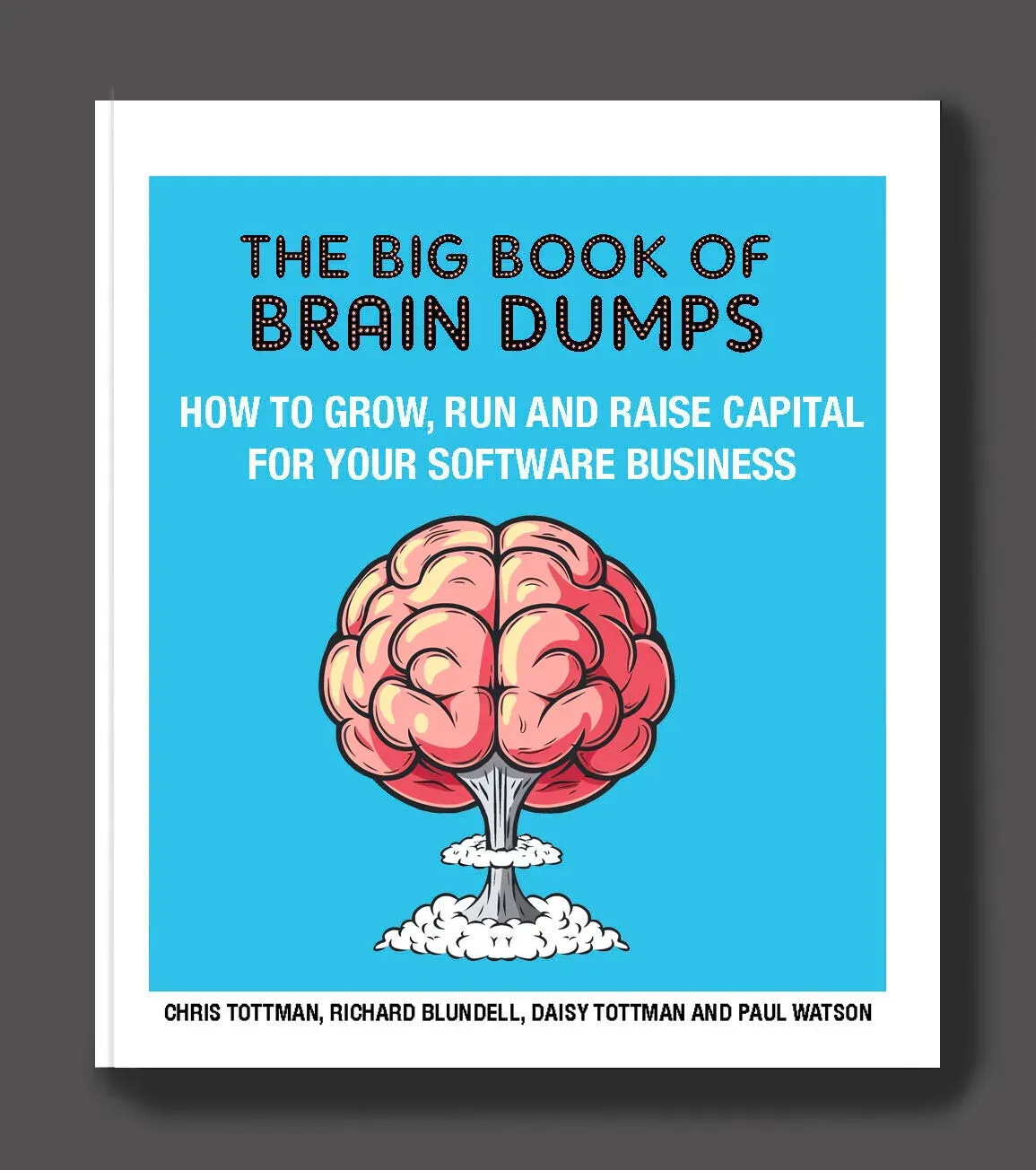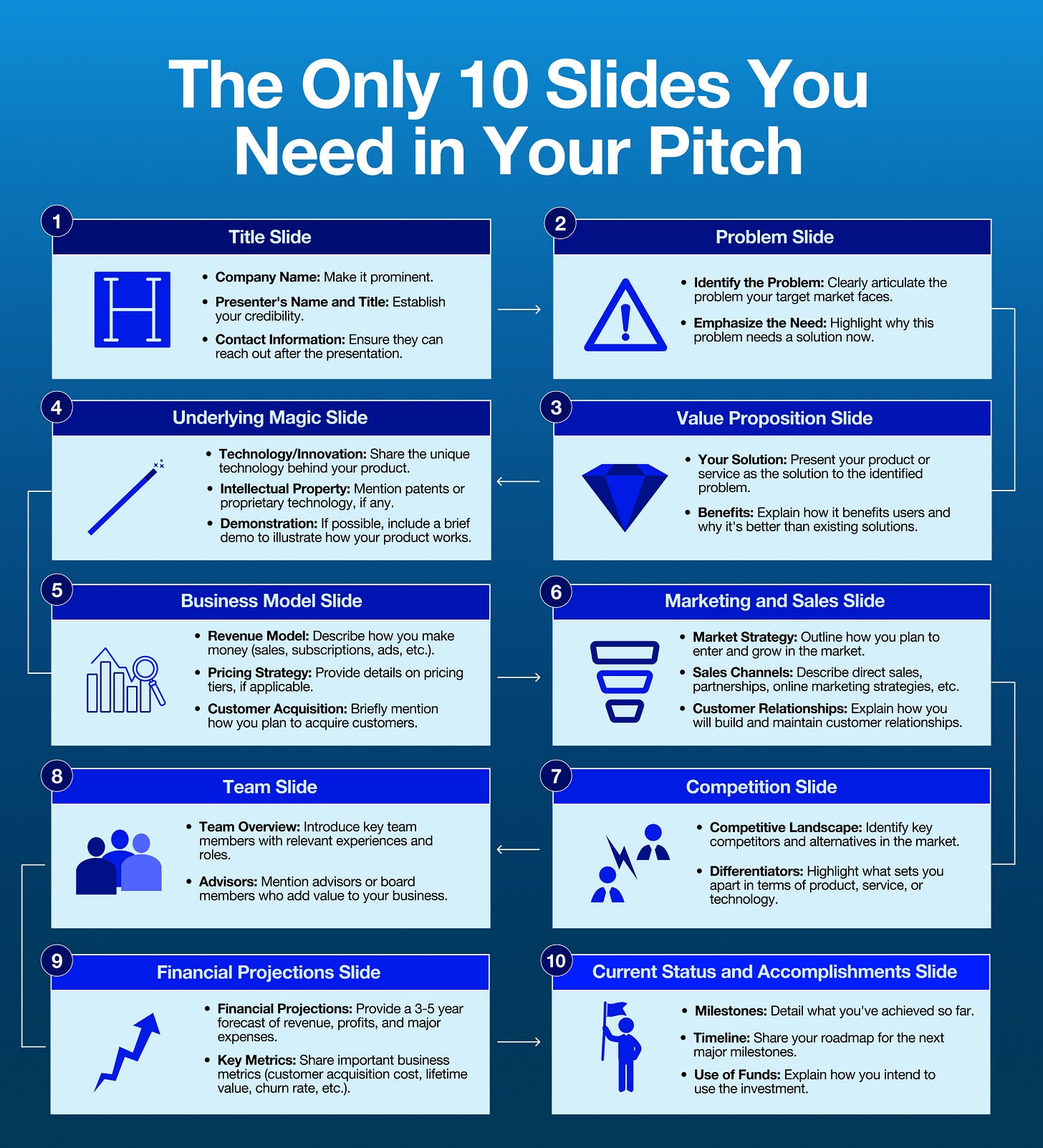🚀 Guy Kawasaki’s 10-Slide Pitch Deck Formula: How to Hook Investors and Nail Your Next Raise
The no-fluff guide to building a clear, confident, and investor-ready deck that gets results.
👋 Hey, Chris here! Welcome to BrainDumps—a weekly series from The Founders Corner. If you’ve been reading along, you know this series is a preview of a bigger project. Well, it’s finally here: The Big Book of BrainDumps is out now!
It isn’t a theory book—it’s the founder’s field manual. Inside, you’ll find 70 powerful frameworks distilled from 30+ years scaling software companies to hundreds of millions in ARR, 20+ years investing in 500+ B2B tech startups, and over $1B of shareholder value created. From raising capital to hiring your first VP of Sales, this book turns scars and successes into practical playbooks you’ll return to again and again. I expect most copies will become well-worn, scribbled on, and dog-eared—because it works.
📑 Table of Contents
Title Slide
Problem Slide
Solution Slide
Underlying Magic Slide
Business Model Slide
Marketing & Sales Slide
Competition Slide
Team Slide
Financials Slide
Current Status, Roadmap & Ask Slide
Closing Thoughts: Why This Framework Still Works
Here’s another take on creating a short and concise deck – Guy Kawasaki’s renowned 10-Slide Pitch Deck Framework. It covers much of the same detail as The Pitch Deck Cheat Sheet but is worth representing here nonetheless as reinforcement. Known for its clarity and simplicity, Guy’s framework distils the essence of your business into ten critical slides, each addressing a key aspect of your venture. It offers a concise yet comprehensive way to communicate your business proposition while keeping the focus sharp and impactful.
This framework is one of the few that’s stood the test of time. I first saw it over a decade ago and I still see investors pointing founders to it today. In fact, I’ve seen hundreds of pitch decks over the years, and the most common feedback I find myself giving is: it’s too long, too vague, or too generic. And that’s where Kawasaki’s brilliance lies—he doesn’t just tell you what slides you need, he teaches you how to build a story.
Let’s walk through each of the ten slides with some commentary, examples, and a few battle scars from the real world of fundraising.
1. Title Slide
Your first impression isn’t just visual—it’s contextual.
This slide seems like admin, but it’s prime real estate. It should contain:
Company name
Your name & title
Contact details (email, LinkedIn, ideally Calendly link)
Tagline or one-liner
You’d be amazed how many times I’ve sat through a pitch without knowing what the company actually does until slide 4. Big mistake. A crisp one-liner gives investors a mental ‘folder’ to put you in.
Example:
“Alinea helps HR teams hire developers faster using AI-powered skill matching.”
Short. Sharp. Got it.
2. Problem Slide
What urgent, unavoidable pain are you solving?
The best pitches frame the problem in terms of stakes. What’s broken? Who’s suffering? How much money or time is being lost?
Founders often skip this or trivialise it with broad claims like “HR is broken.” That’s not a problem, that’s a tweet.
A better example might be:
“Tech hiring takes 42 days on average and costs £15,000 per hire. 60% of candidates fail technical screens.”
Now I’m listening.
Pro tip: Add a pain statement diagram here—a visual that shows the before-and-after state for the user or customer. This connects logic to emotion.
3. Solution Slide
Enter: your product. But keep it tight.
Don’t bury the lede. What is the thing you’ve built or are building, and how does it solve the problem above?
Avoid jargon. Use plain English.
Wrong: “An ML-optimised workforce orchestration platform leveraging proprietary data sets.”
Right: “A hiring tool that matches devs to jobs using a 5-minute skills test.”
If your solution is complex, include a simple product diagram or screenshot. But resist the temptation to do a product demo mid-pitch. It kills momentum.
4. Underlying Magic Slide
Aka: “What’s your secret sauce?”
This is one of my favourite slides because it tells me if you’ve thought deeply about your edge. It could be:
Proprietary tech
Unique data
A patent
A founder insight (lived experience or domain knowledge)
Distribution strategy
Example:
“Our founders previously scaled engineering teams at Spotify and Meta, and built the internal hiring tools that reduced time-to-hire by 45%.”
That’s real. That’s an edge. Investors perk up at this slide.
5. Business Model Slide
How do you make money—today and tomorrow?
This is not just about revenue—it’s about how revenue is generated and sustained. Include:
Pricing strategy
Customer types (SMB? Enterprise?)
Average revenue per user (ARPU)
Gross margins (if relevant)
Example:
SaaS pricing: £99/month/team. LTV: £1,500. CAC: £300. 80% gross margin.
You don’t need all the answers, but show you’ve thought about unit economics.
6. Marketing & Sales Slide
“If you build it”... no, they won’t come.
This slide is your go-to-market playbook. Investors want to know how you’re going to:
Acquire customers
Retain them
Grow accounts
Talk channels (SEO, cold outbound, partnerships), cost of acquisition (CAC), and sales cycles. For B2B SaaS founders, show:
Who buys (job title)
How long it takes to close
Who signs the cheque
Example:
“Direct sales to Heads of Engineering. Avg deal: £15K ARR. 30-day cycle. Outbound email converts at 7% to demo.”
7. Competition Slide
“We don’t have any competitors” = 🚨🚨🚨
Even if you’re truly first, your customers are solving the problem somehow today.
Use a 2x2 grid or table to position yourself. Highlight your unique wedge.
Example:
“Unlike Codility or HackerRank, we assess devs in 5 minutes using real code snippets, not academic tests.”
Be honest. Show you’ve done the homework. Bonus points if you can explain why now is the time your solution wins.
8. Team Slide
Who are the believers behind the curtain?
Founders often underplay this. But at early stage, investors mostly back people.
Include names, logos (for credibility), and key roles. Investors want to know:
Who’s full-time?
Who’s built what before?
What gaps still exist?
Example:
CTO built hiring systems at Meta. CEO scaled B2B sales at Intercom. Designer led UX at Revolut. Currently hiring VP Engineering.
Short bios, logos, and photos (optional) go a long way.
9. Financials Slide
No hockey sticks without the blade.
3–5 year projections are fine, but focus on:
Revenue
Expenses
Key assumptions (e.g. CAC, LTV, churn)
Investors know your numbers are guesses. What they’re really looking for is whether your logic is sound.
Avoid overcomplication. Use a simple table and explain:
“We need 200 customers paying £1K/month to hit £2.4M ARR.”
That’s it. Keep it tight.
10. Current Status, Roadmap & Ask Slide
What have you done, where are you going, and what do you need?
This is your moment. Be specific.
Milestones hit (users, MRR, product builds)
Upcoming goals (e.g. “launch v2,” “hire sales lead”)
Fundraising amount
Use of funds
Example:
“£1M raise to grow from 50 to 300 customers, hire 3 engineers, expand to US.”
Don’t fluff it. Don’t shy away. Say what you need and what it’ll deliver.
Closing Thoughts: Why This Framework Still Works
Guy’s 10-slide framework isn’t just elegant—it’s efficient. In 10 slides, you force clarity, remove fluff, and get to the heart of what matters:
Is the problem real?
Is the solution credible?
Is the team capable?
Is the business viable?
The truth is, most early-stage pitches fail not because the idea is bad, but because it’s unclear. This format gives Founders guardrails without straitjackets.
If you’re a Founder raising your first round—or even your third—start here. Use this structure. Tighten your story. Deliver it with conviction. Investors aren’t looking for perfection. They’re looking for belief, clarity, and momentum.
And if you ever need a gut-check on your pitch, send it my way. Seen more decks than I’ve had hot dinners. Happy to take a look.
—Chris Tottman




It’s amazing how Kawasaki’s framework still sets the gold standard after all these years. There’s something timeless about the balance he strikes between storytelling and structure -it forces clarity without killing creativity. Most founders could save themselves countless revisions if they just embraced that discipline early on. I’ve seen pitch decks crumble under the weight of too many buzzwords, while the best ones often follow this very formula. It’s a true masterclass in doing more with less.
Which of the ten slides do you find founders struggle with the most when putting this framework into practice?
Great framework from master Kawasaki... (And, of course Chris Tottman)